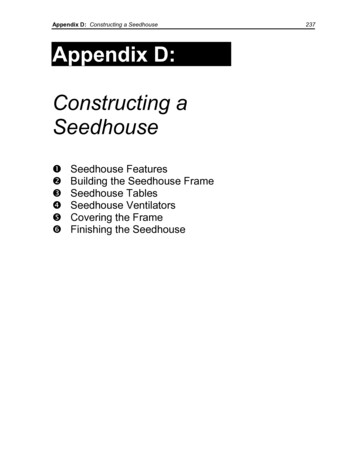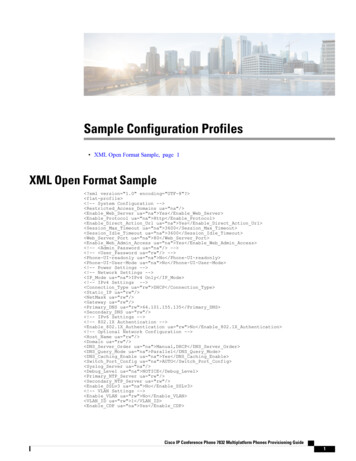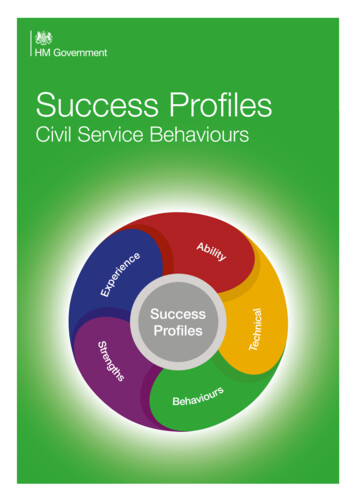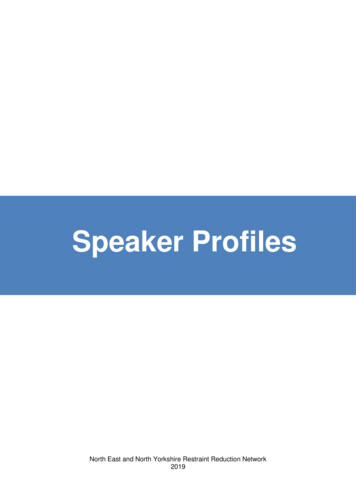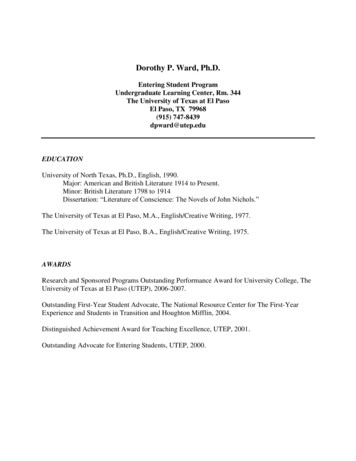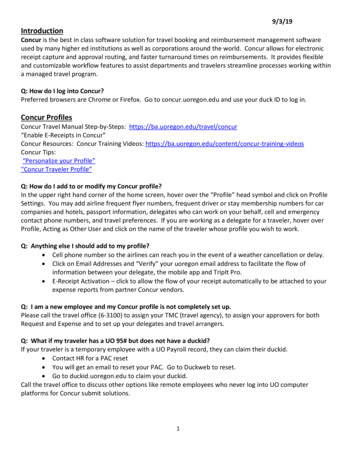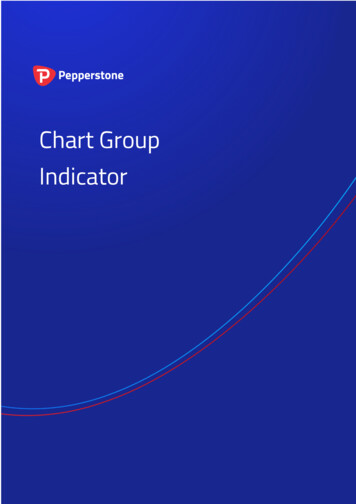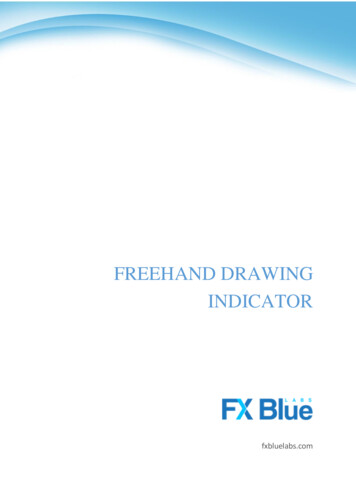
Transcription
Appendix II. Indicator profilesThe indicator profiles summarize results of the Africa SDG Index and Dashboardsreport for each of the 97 indicators selected.For each indicator, we present a brief definition and the source and year of thedata. The full table lists the raw value and color rating by country. More detailedmetadata, including the quantitative thresholds used for each indicator, areavailable online at www.AfricaSDGindex.org.Africa SDG Index and Dashboards Report 2019149
Poverty headcount ratio at 1.90/day(% population)Estimated proportion of each country’s population that in 2018 are living underthe poverty threshold of US 1.90 a day (2011 PPP). Estimated using historicalestimates of the income distribution, projections of population changes by ageand educational attainment, and GDP projections.Source: Cuaresma et al., 2018; World Poverty ClockTrends: 2012–2015IndicatorValue Rating GabonMauritaniaGhanaDjiboutiEthiopiaCabo VerdeBotswanaSudanComorosCote d'IvoireCameroonSão Tomé and .217.421.221.321.421.9 LLLLLL55DDLD555D55IndicatorNamibiaSouth AfricaMaliKenyaBurkina FasoSenegalGuineaAngolaUgandaLiberiaTanzaniaThe GambiaSierra LeoneNigerRwandaNigeriaTogoChadProportion of population living belowthe national poverty lineIndicatorValue Rating GabonCabo .121.423.423.527.828.231.033.435.036.136.637.5 5.638.739.540.242.742.942.943.7 emocratic Republic of the CongoMadagascarBurundiCentral African RepublicSouth SudanEquatorial 56.766.066.670.175.475.677.186.7NANANANARating Trend p5p5p555555p5p––––The percentage of the total population living below the national poverty line.Source: AfDB, AUC, and UNECA, 2018IndicatorValueRwandaSeychellesBeninBurkina FasoMaliComorosNigerNigeriaMozambiqueCote d'IvoireCongoSudanChadSenegalThe GambiaLiberiaMalawiSierra 6.546.746.748.650.951.552.9Africa SDG Index and Dashboards Report 2019Rating TrendRating Trend �–IndicatorValueZambiaTogoGuineaSouth AfricaLesothoCentral African RepublicEswatiniDemocratic Republic of the CongoBurundiSão Tomé and PríncipeGuinea-BissauMadagascarZimbabweEquatorial GuineaSouth .063.964.966.269.370.772.376.882.3NANANARating Trend �–
Population covered bySocial Protection (%)Percentage of population participating in social protection and labor programs (includes direct andindirect beneficiaries). The indicator is estimated by program type, for the entire population and byquintiles of both the post-transfer and pre-transfer welfare distribution. Programs are aggregated intosocial assistance, social insurance and labor market according to World Bank’s ASPIRE classification.Indicators for all social protection and labor programs comprise the sum of social assistance, socialinsurance and labor market figures.Source: World Bank, 2018IndicatorValue Rating TrendIndicatorValueBotswanaSouth oMauritaniaMalawiCote d'IvoireZimbabweDjiboutiRwandaKenyaSierra LeoneCabo e GambiaDemocratic Republic of the CongoNigeriaCongoBeninSouth SudanGuineaBurkina 93.63.42.01.8 �–Rating Trend liTogoAlgeriaAngolaBurundiCentral African RepublicEquatorial GuineaEritreaGuinea-BissauLibyaSão Tomé and .0NANANANANANANANANANANARating Trend �–INDICATOR PROFILESAfrica SDG Index and Dashboards Report 2019151
Prevalence of undernourishment(% population)The percentage of the population whose food intake is insufficient to meet dietaryenergy requirements for minimum one year. Dietary energy requirements aredefined as the amount of dietary energy required by an individual to maintainbody functions, health and normal activity.Source: FAO, 2017IndicatorValue Rating MaliGhanaSouth AfricaCameroonGabonThe GambiaSão Tomé and PríncipeBeninMauritaniaSenegalNigeriaCabo 1.311.311.512.3 DjiboutiGuineaCote d'IvoireEswatiniBurkina FasoEthiopiaAngolaKenyaSudanNamibiaSierra .026.328.530.5Prevalence of stunting (low heightfor-age) in children under 5 yearsof age (%)Rating Trend oLiberiaChadUgandaMadagascarZambiaZimbabweCentral African RepublicBurundiComorosDemocratic Republic of the CongoEquatorial GuineaEritreaLibyaSomaliaSouth ANANANANANARating Trend 5p5pppp5pp––––––––The percentage of children up to the age of 5 years that are stunted, measured asthe percentage that fall below minus two standard deviations from the medianheight for their age, according to the WHO Child Growth Standards.Source: UNICEF, WHO and World Bank, 2017.Trends: 2010–2016 (IHME, 2016)IndicatorValue Rating TrendSeychellesTunisiaAlgeriaMoroccoSenegalSão Tomé and PríncipeGabonGhanaLibyaCongoCote d'IvoireEgyptNamibiaThe GambiaSomaliaEswatiniKenyaEquatorial .622.323.125.025.325.526.026.2 5DDDDLDD5DDLD55D5DIndicatorZimbabweBurkina FasoSouth AfricaTogoGuinea-BissauMauritaniaUgandaMaliSouth iboutiBeninTanzaniaAfrica SDG Index and Dashboards Report 2019Value Rating 2.132.132.433.233.534.034.4 DDD5Dp555555DD55D5IndicatorValue Rating TrendMalawiAngolaRwandaSierra LeoneSudanEthiopiaChadZambiaCentral African RepublicNigerDemocratic Republic of the CongoMozambiqueNigeriaMadagascarEritreaBurundiCabo 42.242.643.143.649.250.355.9NANA 555555555555D555––
Prevalence of wasting in children under5 years of age (%)The percentage of children up to the age of 5 years whose weight fall below minustwo standard deviations from the median weight for their age, according to theWHO Child Growth Standards.Source: UNICEF, WHO and World Bank, 2017Trends: 2010–2016 (IHME, 2016)IndicatorValue Rating TrendEswatiniRwandaMoroccoSouth AfricaMalawiLesothoTunisiaEquatorial GuineaZimbabweGabonUgandaKenyaSão Tomé and 2.32.52.72.82.83.13.23.43.64.04.04.14.34.54.54.7 beriaCote biaBotswanaSenegalCentral African RepublicBurkina FasoDemocratic Republic of the CongoGuineaCongoPrevalence of obesity, BMI 30(% adult .27.27.47.68.18.18.2Rating Trend L5LLLLL55pDDDDDL5pIndicatorValueSierra LeoneEgyptEthiopiaNigerNigeriaComorosThe danDjiboutiSouth SudanCabo 815.015.215.316.321.522.7NANARating Trend DL555Dp5pp555D5D––The percentage of the adult population that has a body mass index (BMI) of 30kg/m2 or higher, based on measured height and weight.Source: WHO, 2017Trends: 2010–2016Value Rating 7.88.08.1 LLLLLLLLLLLLLLLLLLIndicatorValue Rating TrendIndicatorValue Rating TrendAngolaSomaliaTanzaniaTogoMaliSierra ote d'IvoireThe GambiaMauritiusGhanaCameroonCabo 0.810.911.411.8São Tomé and aSouth AfricaEgyptLibyaSouth 26.126.927.428.332.032.5NANA LLLLLLLLLLLLpppppp Africa SDG Index and Dashboards Report 2019pppppppppppppppp––153INDICATOR rundiNigerBurkina FasoMalawiRwandaChadDemocratic Republic of the CongoKenyaMozambiqueCentral African RepublicGuineaComorosEquatorial GuineaZambia
Cereal yield (t/ha)Cereal yield, measured as tons per hectare of harvested land. Production data oncereals relate to crops harvested for dry grain only and excludes crops harvested forhay or green for food, feed, or silage and those used for grazing.Source: FAO, 2017Trends: 2010–2016IndicatorValue Rating TrendEgyptMadagascarSouth AfricaMauritiusEthiopiaZambiaCote d'IvoireSão Tomé and PríncipeDjiboutiUgandaSierra 1.5 LLLLLp5pppL555pppDIndicatorRwandaBurundiSouth alawiLiberiaMauritaniaBurkina FasoGuineaEswatiniTogoMoroccoAngolaFertilizer consumption(kg per hectare of arable land)IndicatorValue Rating naMoroccoTunisiaSouth AfricaCote a tic Republic of the CongoUgandaCongo154 LLLLLLLLLLDLLD5DppAfrica SDG Index and Dashboards Report 2019Value Rating 1.10.90.9 pLL55pp55p55p5p5pDIndicatorCentral African RepublicChadThe GambiaCongoMozambiqueDemocratic Republic of the otswanaEritreaCabo VerdeEquatorial GuineaSeychellesValue Rating 0.2NANA ppp5p555p5pp55pp––The quantity of plant nutrients used per unit of arable land.Source: FAO, 2017Trends: 2010–2016Value Rating 23.72.82.51.91.8 D5p5p55pp5pp5p55ppIndicatorGuineaThe GambiaNigerCentral African RepublicCabo VerdeChadComorosDjiboutiEquatorial aSão Tomé and PríncipeSierra LeoneSomaliaSouth SudanValue Rating Trend1.61.20.40.3NANANANANANANANANANANANANANA ppp–––––––––––––––
Maternal mortality rate(per 100,000 live births)The estimated number of women, between the age of 15-49, who die frompregnancy-related causes while pregnant, or within 42 days of termination ofpregnancy, per 100,000 live births.Source: WHO, 2017Trends: 2010–2015IndicatorValue Rating TrendLibyaEgyptCabo VerdeMauritiusTunisiaMoroccoBotswanaSouth AfricaAlgeriaSão Tomé and 315319 LLLLLLLD55DDDD55D5IndicatorValueComorosEquatorial GuineaUgandaEthiopiaMadagascarTogoBurkina 3368371389398405442443477487489501510549Births attended by skilled healthpersonnel (%)Rating Trend D5DLD555D55pDDD5D5IndicatorValue Rating 634Cote d'Ivoire645Guinea679Democratic Republic of the Congo 693The Gambia706Burundi712Liberia725Somalia732South Sudan789Nigeria814Chad856Central African Republic882Sierra Leone1360SeychellesNA D 5 5 D p 5 5 5 5 5 5 5 5 5 D 5 D –The percentage of births attended by personnel trained to give the necessarysupervision, care, and advice to women during pregnancy, labor, and thepostpartum period; to conduct deliveries on their own; and to care for newborns.Source: UNICEF, 2017Value Rating h AfricaAlgeriaSão Tomé and PríncipeEgyptCabo 91.290.789.889.388.388.287.485.182.2Democratic Republic of the CongoBurkina FasoZimbabweLesothoSudanBeninUgandaCote d'IvoireMoroccoTunisiaGhanaMauritaniaEquatorial GuineaCameroonTanzaniaZambiaGuineaKenya –LL–––––p5LL––––L–Value Rating 9.368.364.763.563.362.761.8 alue Rating TrendLiberiaSierra LeoneThe gascarMaliNigeriaCentral African RepublicNigerEritreaEthiopiaChadSouth .743.040.039.734.127.720.219.49.4 Africa SDG Index and Dashboards Report NDICATOR PROFILESIndicator
Neonatal mortality rate(per 1,000 live births)IndicatorValue Rating TrendLibyaTunisiaMauritiusSeychellesCabo VerdeSouth AfricaEgyptMoroccoSão Tomé and 14.414.916.417.417.517.818.419.420.220.5 LLLLLLLLLDLDDDDDDDThe number of newborn infants (neonates) dying before reaching 28 days of age,per 1,000 live births.Source: UNICEF, et al.
indirect beneficiaries). The indicator is estimated by program type, for the entire population and by quintiles of both the post-transfer and pre-transfer welfare distribution. Programs are aggregated into social assistance, social insurance and labor market according to World Bank’s ASPIRE classification.
